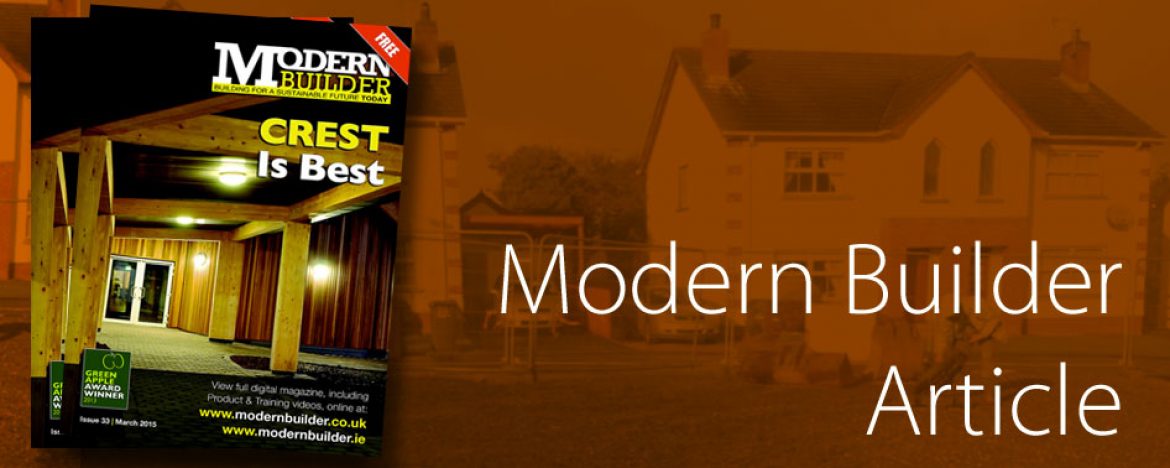
Modern Builder Article
ISSUE 33: MARCH | WWW.MODERNBUILDER.CO.UK
Zero Energy Without The Zany Bits
By John Ross, Research Lecturer, and MCS Heat Pump Inspector for Ireland
Over the past few years there has been a constant information flow of emerging zero carbon houses models, along with all the frills that go with them.
But what about a “no frills” home constructed from current materials, using existing methods of construction with a few added tweaks? Most of these new ZC homes have seen the use of modern,somewhat expensive techniques,throw in a combination of artistic licence and a dash of expression and we end up with a mix of some strange, abstract concepts – but it doesn’t need to be like that. Yes it doesn’t need to be “rocket science” – thanks to a local architect/sustainability consultant Barry Gallagher.
Barry has always been a strong advocate of using thermal mass as an energy medium, utilising heavyweight construction,traditional skills and locally sourced sustainable materials to attain Carbon Zero buildings. Barry also said to me: “Our culture and lifestyle is what it is, so rather than trying to change it completely, why not just build on what we have and are familiar with?”
“The housing sector has made progress in developing solutions to meet new tough performance standards, but the next challenge is bringing together the lessons learned into mainstream housing, in a cost-effective and practical manner.” – Barry Gallagher – Zero Home System
If we approach change in this way, people will understand and respond – and it is the response that so crucial to the success of so many good ideas. The fruit of Barry’s methods has seen several excellent homes designed and built, the latest being two semi-detached homes in Maghera. The homes in question have been carefully developed to perfectly blend in with existing homes in an estate (part of the terms of the planning application). The homes are in this sense a work of art, equivalent to the existing stock and a view of what’s possible especially in terms of perception and costs to the buyer.
Barry’s main aim was to show that on a small piece of land in an ordinary estate, new homes could be integrated. Although similar in appearance they are in fact highly future-proofed, energy efficient homes designed to simplify rather than complicate. Affordable, comfortable living was the target and the homes look completely normal with a few added bits to generate heat and power, which, along with the highly insulated fabric, allows the home to have a running cost of around £5.00 a year for heat and power.
” It’s amazing what can happen when people in a project share a vision and adapt and adhere to a system that it can generate a number of real benefits.” – Barry Gallagher – Zero Home System
Benefits
AFFORDABLE HOMES | Targeting the reduction/eradication of Fuel Poverty, leaving the tenant with dramatically reduced running costs, more disposable income and a better quality of life;
ENHANCED PROPERTY PORTFOLIO | –stronger assets by future proofing, delivers enhanced borrowing power and preferred loans for projects;
WHOLE OF LIFE | considers all the costs associated with the life of the building, from its inception to construction,occupation and operation and disposal;
LOWER MAINTENANCE COSTS | facilitating the management of rented units on a whole life basis and best return on investment through design methods;
THE CONCEPT GATHERS MOMENTUM | providing a strong economic case to attract Government grants/subsidies by facilitating the green agenda and meeting government targets.
GOING FORWARD | The housing sector has made progress in developing solutions to meet new tough performance standards, but the next challenge is bringing together the lessons learned into mainstream housing,in a cost-effective and practical manner.
It is time to be honest and move on from accepting the early days of“eco-bling” when some designers/developers were sticking a few photovoltaic (PV) or a solar thermal panel on the roof and calling it a green home. Without looking at and substantiating their real credentials some new constructions often amounted to no more than sales jargon.
”Zerohome System” recognises the state of the industry, the truth that building modern homes needs a more targeted approach.The learning and time needed to build homes that save energy,don’t overheat, are well ventilated etc doesn’t happen to the industry overnight. There needs to be a professional team, trained and upskilled in this theory, to deliver the desired outcome, from top to bottom in the process.
In parallel, possibly computer modelling tools in the form of SAP, forces mainstream thinking onto meeting performances, resulting in a percentage of actual home failures. The need for a control mechanism that stabilises the thinking in terms of every design meeting their goal has to happen,especially when renewables interact with the design outcomes.
Simply, the present industry allows for freedom to build and claim a level of compliance without a real measure of assessment. Several guiding theories don’t help with the“Code for Sustainable Homes, Passive House” all giving out different messages to the industry and the market. In fact, the recent weakening on the CFSH and others about renewables by government has further mixed the message to the industry and market.
“It must do what it says on the tin” Zerohome System understands that a house is there to be lived in and enjoyed by all the family and should be “whole-of-life” and used as a family needs to use it.
For social housing this challenge is particularly demanding since energy efficiency enhancements to the fabric and services must not impact on the core design requirements within this sector,which include;
- Affordability
- Low maintenance
- Simplicity (easy to operate),
- Use of systems with a proven track record
- Robust/durable solutions.
Future-proofing Tradition & Addition is the engine of the Zerohome System approach. The Zero Home System approach embraces these ideals and benefits from using mainstream construction methods supported by a well-established supply chain. These topics will be covered further in an upcoming Modern Builder editorial, so stay tuned for more!
 If you would like more information
If you would like more information
please contact John Ross
